Leadership, Accountability, and Strategic Outcome Management Report
VerifiedAdded on 2023/06/18
|9
|2660
|494
Report
AI Summary
This report discusses leadership approaches to manage and implement strategic outcomes, focusing on transformational and transactional leadership styles. It identifies key parties accountable for decisions and actions, including employees, employers, government agencies, coordinators, and administrative bodies. The report also presents strategies for controlling disruptive emotions and impulses, such as avoiding personal responses, managing emotions, shaping interpersonal relationships positively, self-control, emotional intelligence, and preventing negative consequences. The importance of aligning organizational events with employee performance is also highlighted. The analysis emphasizes the role of effective leadership in achieving organizational objectives by fostering a positive and controlled environment.
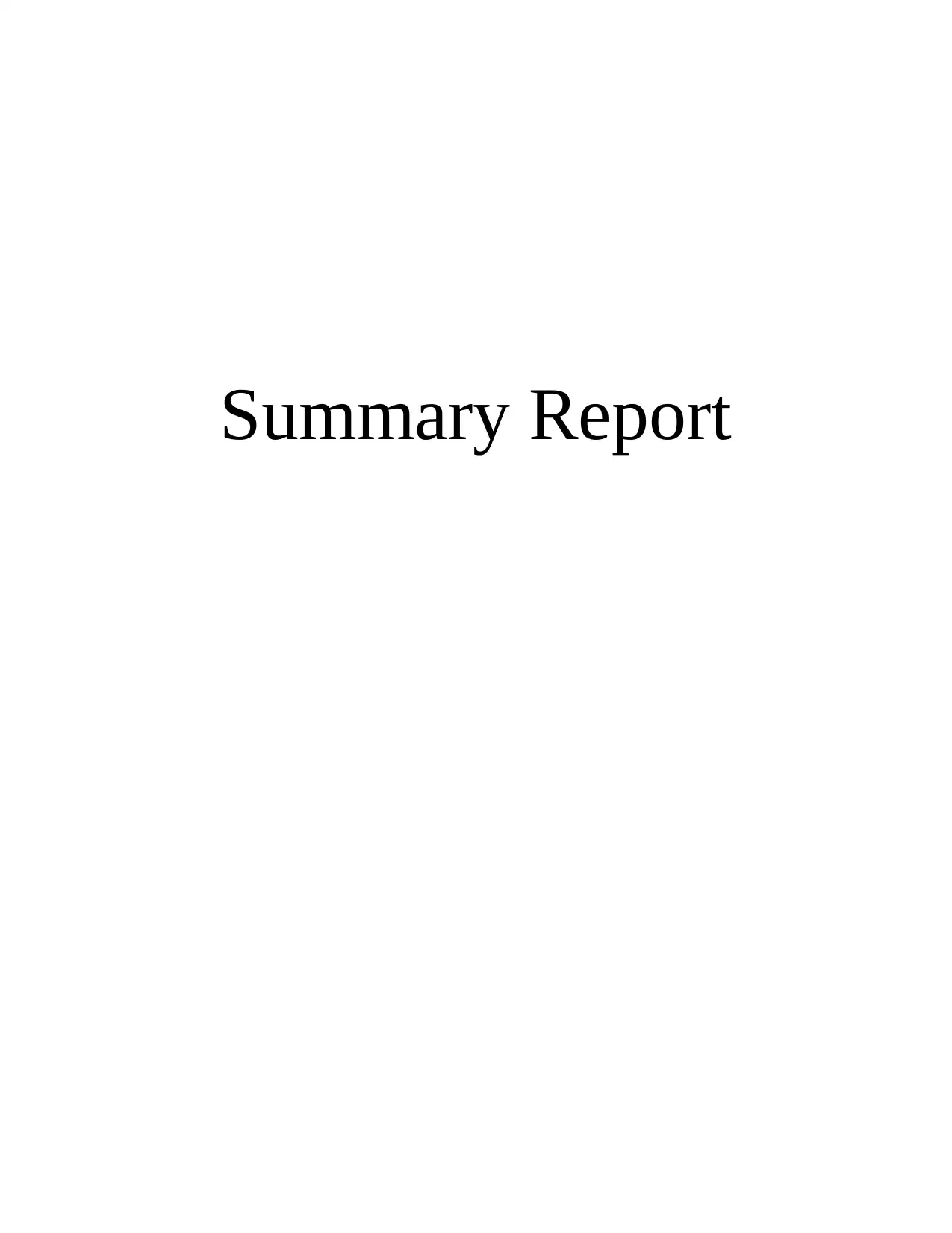
Summary Report
Paraphrase This Document
Need a fresh take? Get an instant paraphrase of this document with our AI Paraphraser
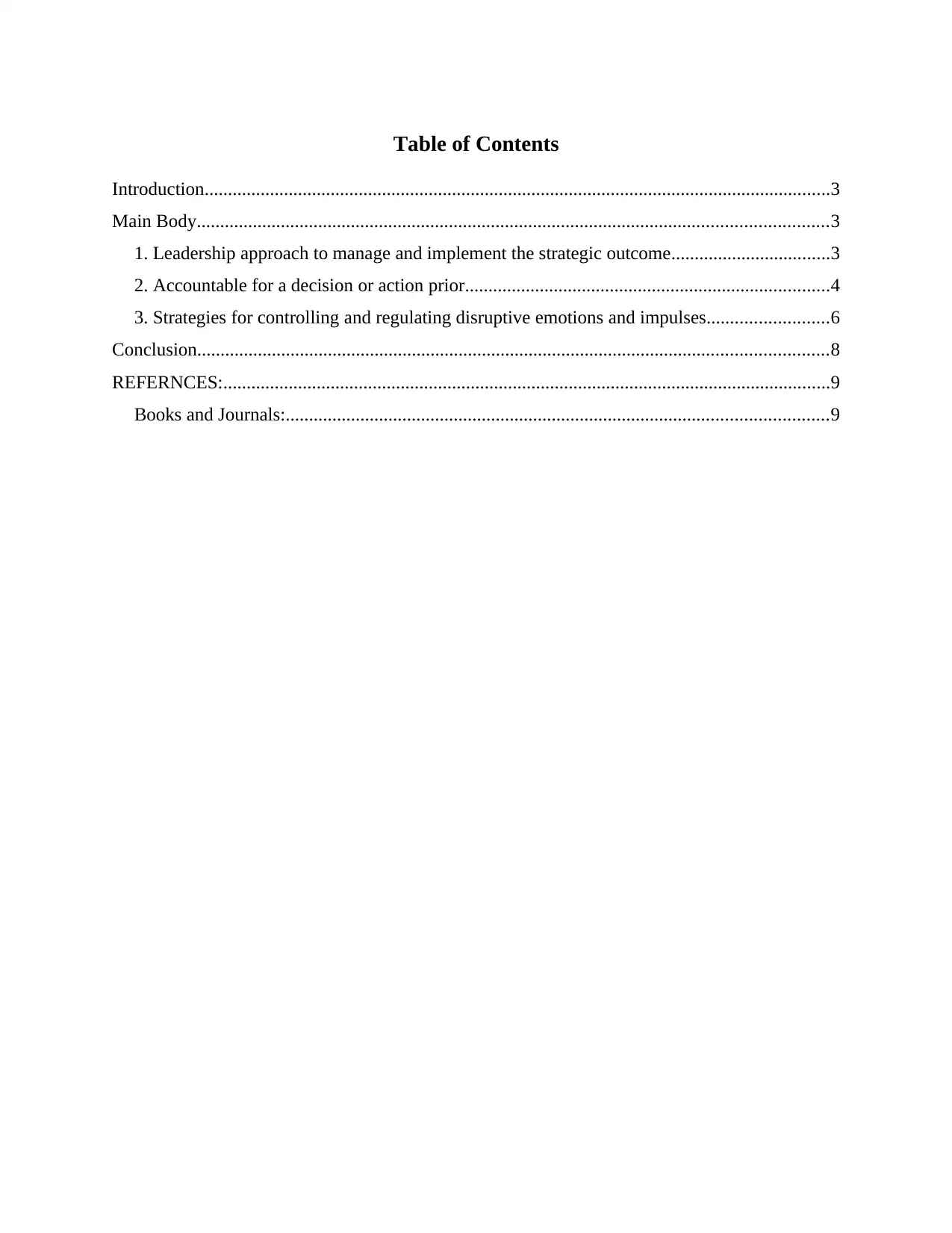
Table of Contents
Introduction......................................................................................................................................3
Main Body.......................................................................................................................................3
1. Leadership approach to manage and implement the strategic outcome..................................3
2. Accountable for a decision or action prior..............................................................................4
3. Strategies for controlling and regulating disruptive emotions and impulses..........................6
Conclusion.......................................................................................................................................8
REFERNCES:..................................................................................................................................9
Books and Journals:....................................................................................................................9
Introduction......................................................................................................................................3
Main Body.......................................................................................................................................3
1. Leadership approach to manage and implement the strategic outcome..................................3
2. Accountable for a decision or action prior..............................................................................4
3. Strategies for controlling and regulating disruptive emotions and impulses..........................6
Conclusion.......................................................................................................................................8
REFERNCES:..................................................................................................................................9
Books and Journals:....................................................................................................................9
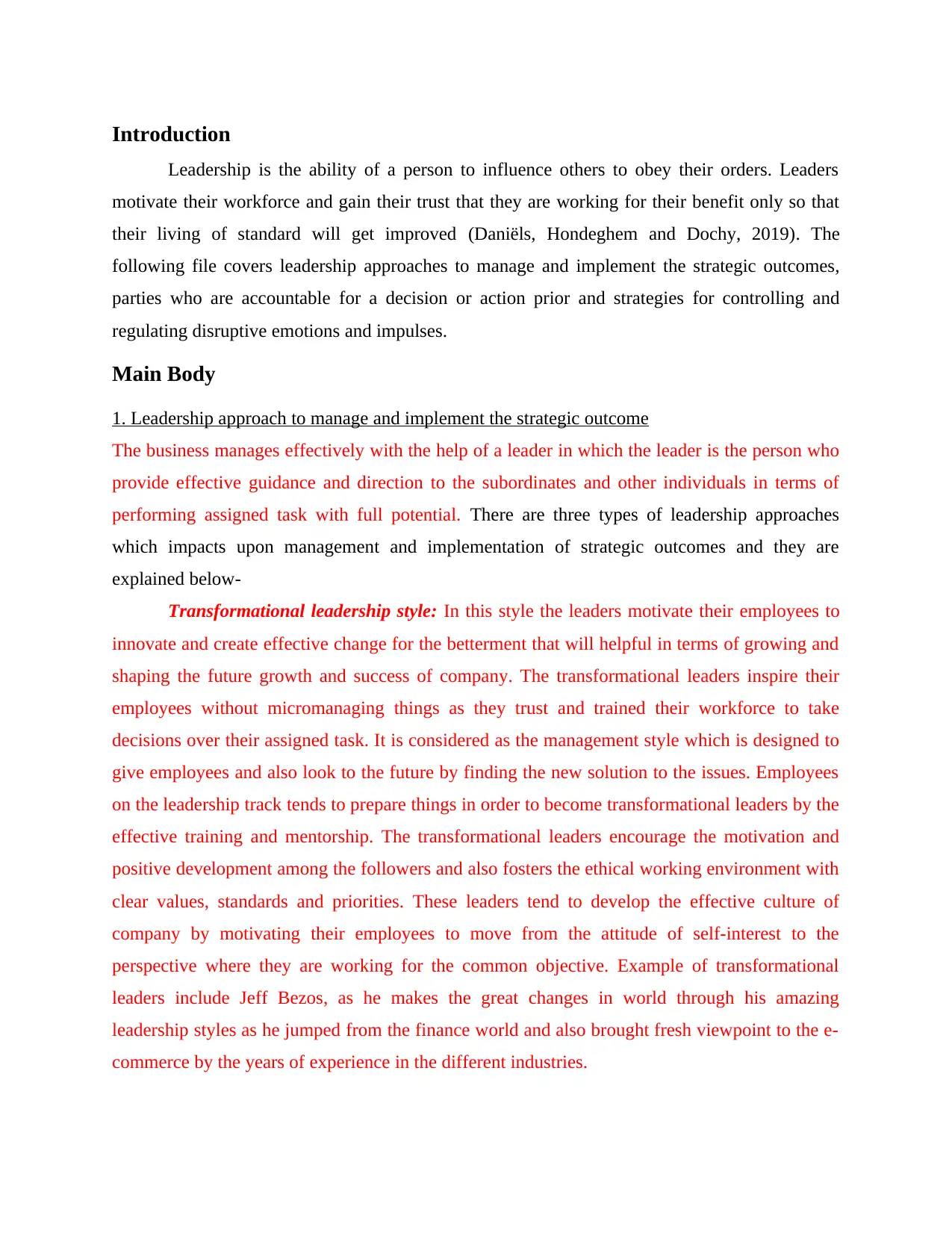
Introduction
Leadership is the ability of a person to influence others to obey their orders. Leaders
motivate their workforce and gain their trust that they are working for their benefit only so that
their living of standard will get improved (Daniëls, Hondeghem and Dochy, 2019). The
following file covers leadership approaches to manage and implement the strategic outcomes,
parties who are accountable for a decision or action prior and strategies for controlling and
regulating disruptive emotions and impulses.
Main Body
1. Leadership approach to manage and implement the strategic outcome
The business manages effectively with the help of a leader in which the leader is the person who
provide effective guidance and direction to the subordinates and other individuals in terms of
performing assigned task with full potential. There are three types of leadership approaches
which impacts upon management and implementation of strategic outcomes and they are
explained below-
Transformational leadership style: In this style the leaders motivate their employees to
innovate and create effective change for the betterment that will helpful in terms of growing and
shaping the future growth and success of company. The transformational leaders inspire their
employees without micromanaging things as they trust and trained their workforce to take
decisions over their assigned task. It is considered as the management style which is designed to
give employees and also look to the future by finding the new solution to the issues. Employees
on the leadership track tends to prepare things in order to become transformational leaders by the
effective training and mentorship. The transformational leaders encourage the motivation and
positive development among the followers and also fosters the ethical working environment with
clear values, standards and priorities. These leaders tend to develop the effective culture of
company by motivating their employees to move from the attitude of self-interest to the
perspective where they are working for the common objective. Example of transformational
leaders include Jeff Bezos, as he makes the great changes in world through his amazing
leadership styles as he jumped from the finance world and also brought fresh viewpoint to the e-
commerce by the years of experience in the different industries.
Leadership is the ability of a person to influence others to obey their orders. Leaders
motivate their workforce and gain their trust that they are working for their benefit only so that
their living of standard will get improved (Daniëls, Hondeghem and Dochy, 2019). The
following file covers leadership approaches to manage and implement the strategic outcomes,
parties who are accountable for a decision or action prior and strategies for controlling and
regulating disruptive emotions and impulses.
Main Body
1. Leadership approach to manage and implement the strategic outcome
The business manages effectively with the help of a leader in which the leader is the person who
provide effective guidance and direction to the subordinates and other individuals in terms of
performing assigned task with full potential. There are three types of leadership approaches
which impacts upon management and implementation of strategic outcomes and they are
explained below-
Transformational leadership style: In this style the leaders motivate their employees to
innovate and create effective change for the betterment that will helpful in terms of growing and
shaping the future growth and success of company. The transformational leaders inspire their
employees without micromanaging things as they trust and trained their workforce to take
decisions over their assigned task. It is considered as the management style which is designed to
give employees and also look to the future by finding the new solution to the issues. Employees
on the leadership track tends to prepare things in order to become transformational leaders by the
effective training and mentorship. The transformational leaders encourage the motivation and
positive development among the followers and also fosters the ethical working environment with
clear values, standards and priorities. These leaders tend to develop the effective culture of
company by motivating their employees to move from the attitude of self-interest to the
perspective where they are working for the common objective. Example of transformational
leaders include Jeff Bezos, as he makes the great changes in world through his amazing
leadership styles as he jumped from the finance world and also brought fresh viewpoint to the e-
commerce by the years of experience in the different industries.
⊘ This is a preview!⊘
Do you want full access?
Subscribe today to unlock all pages.

Trusted by 1+ million students worldwide
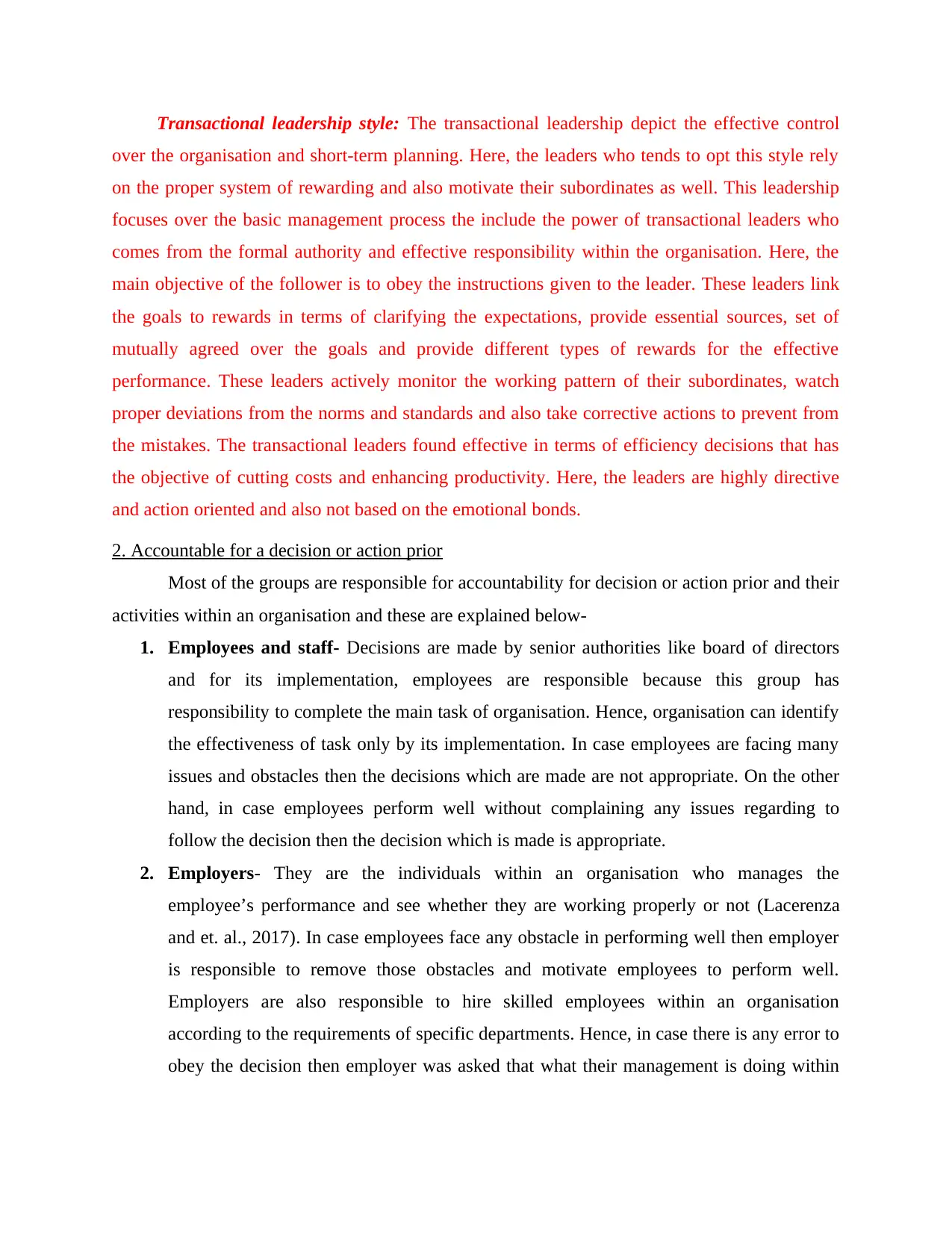
Transactional leadership style: The transactional leadership depict the effective control
over the organisation and short-term planning. Here, the leaders who tends to opt this style rely
on the proper system of rewarding and also motivate their subordinates as well. This leadership
focuses over the basic management process the include the power of transactional leaders who
comes from the formal authority and effective responsibility within the organisation. Here, the
main objective of the follower is to obey the instructions given to the leader. These leaders link
the goals to rewards in terms of clarifying the expectations, provide essential sources, set of
mutually agreed over the goals and provide different types of rewards for the effective
performance. These leaders actively monitor the working pattern of their subordinates, watch
proper deviations from the norms and standards and also take corrective actions to prevent from
the mistakes. The transactional leaders found effective in terms of efficiency decisions that has
the objective of cutting costs and enhancing productivity. Here, the leaders are highly directive
and action oriented and also not based on the emotional bonds.
2. Accountable for a decision or action prior
Most of the groups are responsible for accountability for decision or action prior and their
activities within an organisation and these are explained below-
1. Employees and staff- Decisions are made by senior authorities like board of directors
and for its implementation, employees are responsible because this group has
responsibility to complete the main task of organisation. Hence, organisation can identify
the effectiveness of task only by its implementation. In case employees are facing many
issues and obstacles then the decisions which are made are not appropriate. On the other
hand, in case employees perform well without complaining any issues regarding to
follow the decision then the decision which is made is appropriate.
2. Employers- They are the individuals within an organisation who manages the
employee’s performance and see whether they are working properly or not (Lacerenza
and et. al., 2017). In case employees face any obstacle in performing well then employer
is responsible to remove those obstacles and motivate employees to perform well.
Employers are also responsible to hire skilled employees within an organisation
according to the requirements of specific departments. Hence, in case there is any error to
obey the decision then employer was asked that what their management is doing within
over the organisation and short-term planning. Here, the leaders who tends to opt this style rely
on the proper system of rewarding and also motivate their subordinates as well. This leadership
focuses over the basic management process the include the power of transactional leaders who
comes from the formal authority and effective responsibility within the organisation. Here, the
main objective of the follower is to obey the instructions given to the leader. These leaders link
the goals to rewards in terms of clarifying the expectations, provide essential sources, set of
mutually agreed over the goals and provide different types of rewards for the effective
performance. These leaders actively monitor the working pattern of their subordinates, watch
proper deviations from the norms and standards and also take corrective actions to prevent from
the mistakes. The transactional leaders found effective in terms of efficiency decisions that has
the objective of cutting costs and enhancing productivity. Here, the leaders are highly directive
and action oriented and also not based on the emotional bonds.
2. Accountable for a decision or action prior
Most of the groups are responsible for accountability for decision or action prior and their
activities within an organisation and these are explained below-
1. Employees and staff- Decisions are made by senior authorities like board of directors
and for its implementation, employees are responsible because this group has
responsibility to complete the main task of organisation. Hence, organisation can identify
the effectiveness of task only by its implementation. In case employees are facing many
issues and obstacles then the decisions which are made are not appropriate. On the other
hand, in case employees perform well without complaining any issues regarding to
follow the decision then the decision which is made is appropriate.
2. Employers- They are the individuals within an organisation who manages the
employee’s performance and see whether they are working properly or not (Lacerenza
and et. al., 2017). In case employees face any obstacle in performing well then employer
is responsible to remove those obstacles and motivate employees to perform well.
Employers are also responsible to hire skilled employees within an organisation
according to the requirements of specific departments. Hence, in case there is any error to
obey the decision then employer was asked that what their management is doing within
Paraphrase This Document
Need a fresh take? Get an instant paraphrase of this document with our AI Paraphraser
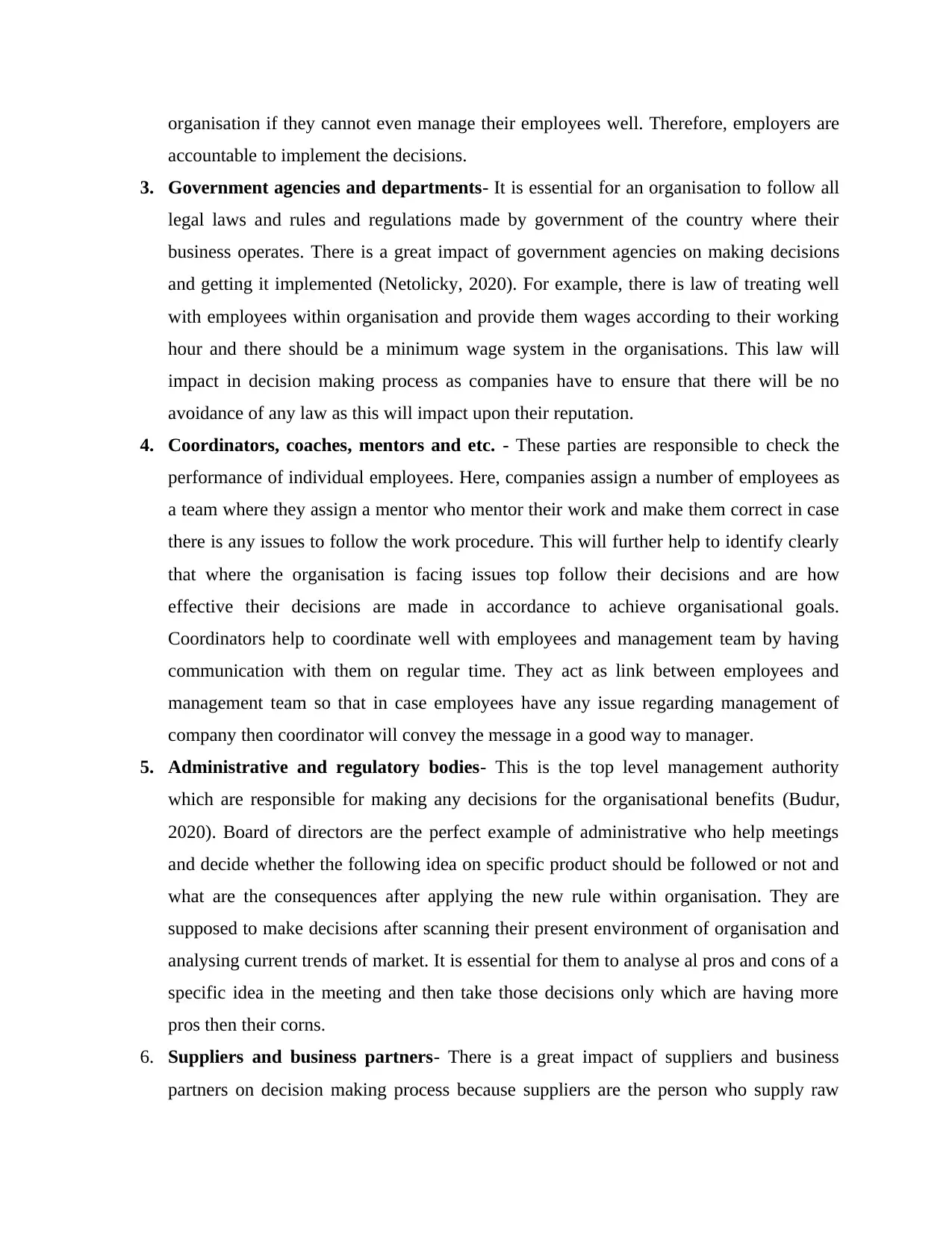
organisation if they cannot even manage their employees well. Therefore, employers are
accountable to implement the decisions.
3. Government agencies and departments- It is essential for an organisation to follow all
legal laws and rules and regulations made by government of the country where their
business operates. There is a great impact of government agencies on making decisions
and getting it implemented (Netolicky, 2020). For example, there is law of treating well
with employees within organisation and provide them wages according to their working
hour and there should be a minimum wage system in the organisations. This law will
impact in decision making process as companies have to ensure that there will be no
avoidance of any law as this will impact upon their reputation.
4. Coordinators, coaches, mentors and etc. - These parties are responsible to check the
performance of individual employees. Here, companies assign a number of employees as
a team where they assign a mentor who mentor their work and make them correct in case
there is any issues to follow the work procedure. This will further help to identify clearly
that where the organisation is facing issues top follow their decisions and are how
effective their decisions are made in accordance to achieve organisational goals.
Coordinators help to coordinate well with employees and management team by having
communication with them on regular time. They act as link between employees and
management team so that in case employees have any issue regarding management of
company then coordinator will convey the message in a good way to manager.
5. Administrative and regulatory bodies- This is the top level management authority
which are responsible for making any decisions for the organisational benefits (Budur,
2020). Board of directors are the perfect example of administrative who help meetings
and decide whether the following idea on specific product should be followed or not and
what are the consequences after applying the new rule within organisation. They are
supposed to make decisions after scanning their present environment of organisation and
analysing current trends of market. It is essential for them to analyse al pros and cons of a
specific idea in the meeting and then take those decisions only which are having more
pros then their corns.
6. Suppliers and business partners- There is a great impact of suppliers and business
partners on decision making process because suppliers are the person who supply raw
accountable to implement the decisions.
3. Government agencies and departments- It is essential for an organisation to follow all
legal laws and rules and regulations made by government of the country where their
business operates. There is a great impact of government agencies on making decisions
and getting it implemented (Netolicky, 2020). For example, there is law of treating well
with employees within organisation and provide them wages according to their working
hour and there should be a minimum wage system in the organisations. This law will
impact in decision making process as companies have to ensure that there will be no
avoidance of any law as this will impact upon their reputation.
4. Coordinators, coaches, mentors and etc. - These parties are responsible to check the
performance of individual employees. Here, companies assign a number of employees as
a team where they assign a mentor who mentor their work and make them correct in case
there is any issues to follow the work procedure. This will further help to identify clearly
that where the organisation is facing issues top follow their decisions and are how
effective their decisions are made in accordance to achieve organisational goals.
Coordinators help to coordinate well with employees and management team by having
communication with them on regular time. They act as link between employees and
management team so that in case employees have any issue regarding management of
company then coordinator will convey the message in a good way to manager.
5. Administrative and regulatory bodies- This is the top level management authority
which are responsible for making any decisions for the organisational benefits (Budur,
2020). Board of directors are the perfect example of administrative who help meetings
and decide whether the following idea on specific product should be followed or not and
what are the consequences after applying the new rule within organisation. They are
supposed to make decisions after scanning their present environment of organisation and
analysing current trends of market. It is essential for them to analyse al pros and cons of a
specific idea in the meeting and then take those decisions only which are having more
pros then their corns.
6. Suppliers and business partners- There is a great impact of suppliers and business
partners on decision making process because suppliers are the person who supply raw
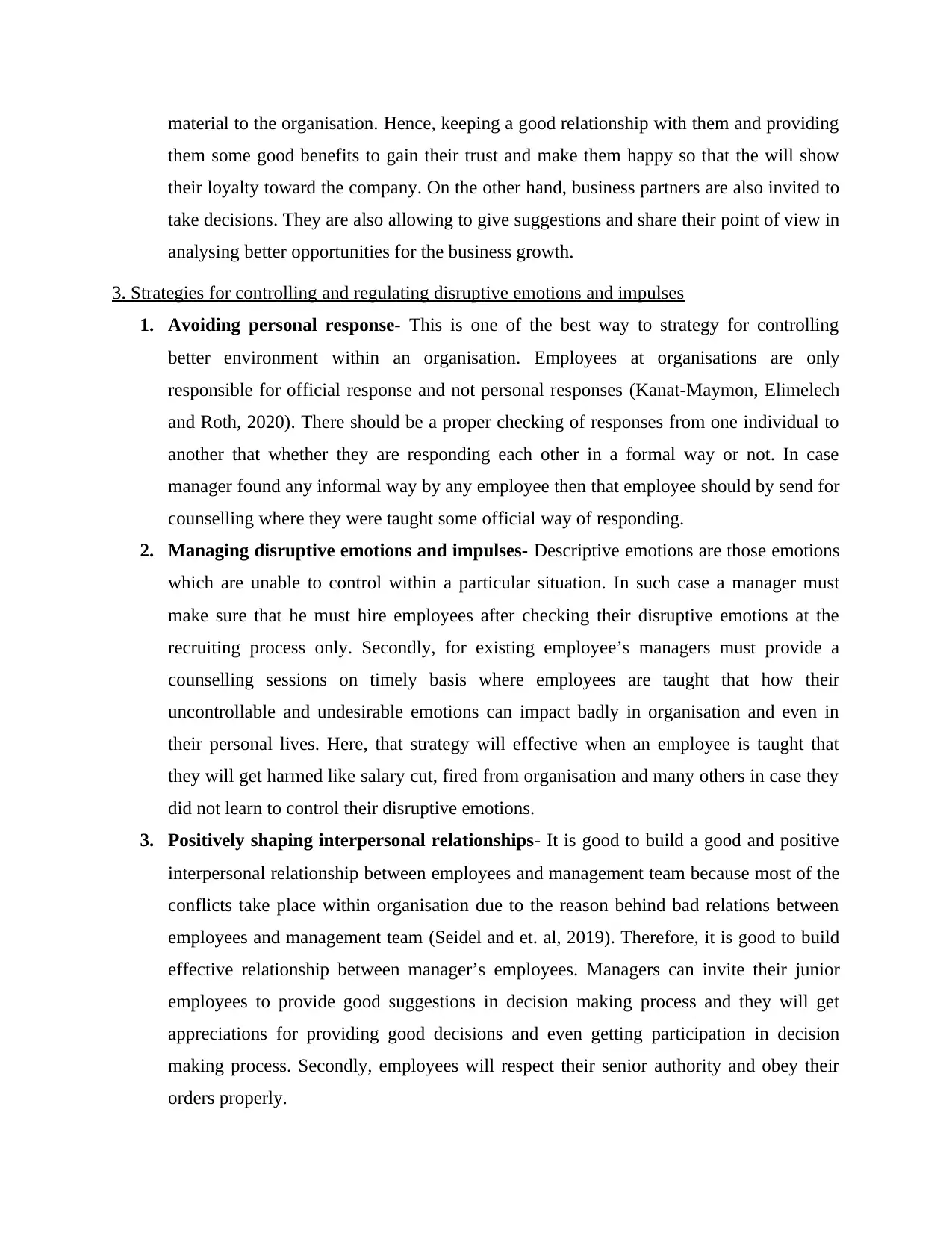
material to the organisation. Hence, keeping a good relationship with them and providing
them some good benefits to gain their trust and make them happy so that the will show
their loyalty toward the company. On the other hand, business partners are also invited to
take decisions. They are also allowing to give suggestions and share their point of view in
analysing better opportunities for the business growth.
3. Strategies for controlling and regulating disruptive emotions and impulses
1. Avoiding personal response- This is one of the best way to strategy for controlling
better environment within an organisation. Employees at organisations are only
responsible for official response and not personal responses (Kanat-Maymon, Elimelech
and Roth, 2020). There should be a proper checking of responses from one individual to
another that whether they are responding each other in a formal way or not. In case
manager found any informal way by any employee then that employee should by send for
counselling where they were taught some official way of responding.
2. Managing disruptive emotions and impulses- Descriptive emotions are those emotions
which are unable to control within a particular situation. In such case a manager must
make sure that he must hire employees after checking their disruptive emotions at the
recruiting process only. Secondly, for existing employee’s managers must provide a
counselling sessions on timely basis where employees are taught that how their
uncontrollable and undesirable emotions can impact badly in organisation and even in
their personal lives. Here, that strategy will effective when an employee is taught that
they will get harmed like salary cut, fired from organisation and many others in case they
did not learn to control their disruptive emotions.
3. Positively shaping interpersonal relationships- It is good to build a good and positive
interpersonal relationship between employees and management team because most of the
conflicts take place within organisation due to the reason behind bad relations between
employees and management team (Seidel and et. al, 2019). Therefore, it is good to build
effective relationship between manager’s employees. Managers can invite their junior
employees to provide good suggestions in decision making process and they will get
appreciations for providing good decisions and even getting participation in decision
making process. Secondly, employees will respect their senior authority and obey their
orders properly.
them some good benefits to gain their trust and make them happy so that the will show
their loyalty toward the company. On the other hand, business partners are also invited to
take decisions. They are also allowing to give suggestions and share their point of view in
analysing better opportunities for the business growth.
3. Strategies for controlling and regulating disruptive emotions and impulses
1. Avoiding personal response- This is one of the best way to strategy for controlling
better environment within an organisation. Employees at organisations are only
responsible for official response and not personal responses (Kanat-Maymon, Elimelech
and Roth, 2020). There should be a proper checking of responses from one individual to
another that whether they are responding each other in a formal way or not. In case
manager found any informal way by any employee then that employee should by send for
counselling where they were taught some official way of responding.
2. Managing disruptive emotions and impulses- Descriptive emotions are those emotions
which are unable to control within a particular situation. In such case a manager must
make sure that he must hire employees after checking their disruptive emotions at the
recruiting process only. Secondly, for existing employee’s managers must provide a
counselling sessions on timely basis where employees are taught that how their
uncontrollable and undesirable emotions can impact badly in organisation and even in
their personal lives. Here, that strategy will effective when an employee is taught that
they will get harmed like salary cut, fired from organisation and many others in case they
did not learn to control their disruptive emotions.
3. Positively shaping interpersonal relationships- It is good to build a good and positive
interpersonal relationship between employees and management team because most of the
conflicts take place within organisation due to the reason behind bad relations between
employees and management team (Seidel and et. al, 2019). Therefore, it is good to build
effective relationship between manager’s employees. Managers can invite their junior
employees to provide good suggestions in decision making process and they will get
appreciations for providing good decisions and even getting participation in decision
making process. Secondly, employees will respect their senior authority and obey their
orders properly.
⊘ This is a preview!⊘
Do you want full access?
Subscribe today to unlock all pages.

Trusted by 1+ million students worldwide
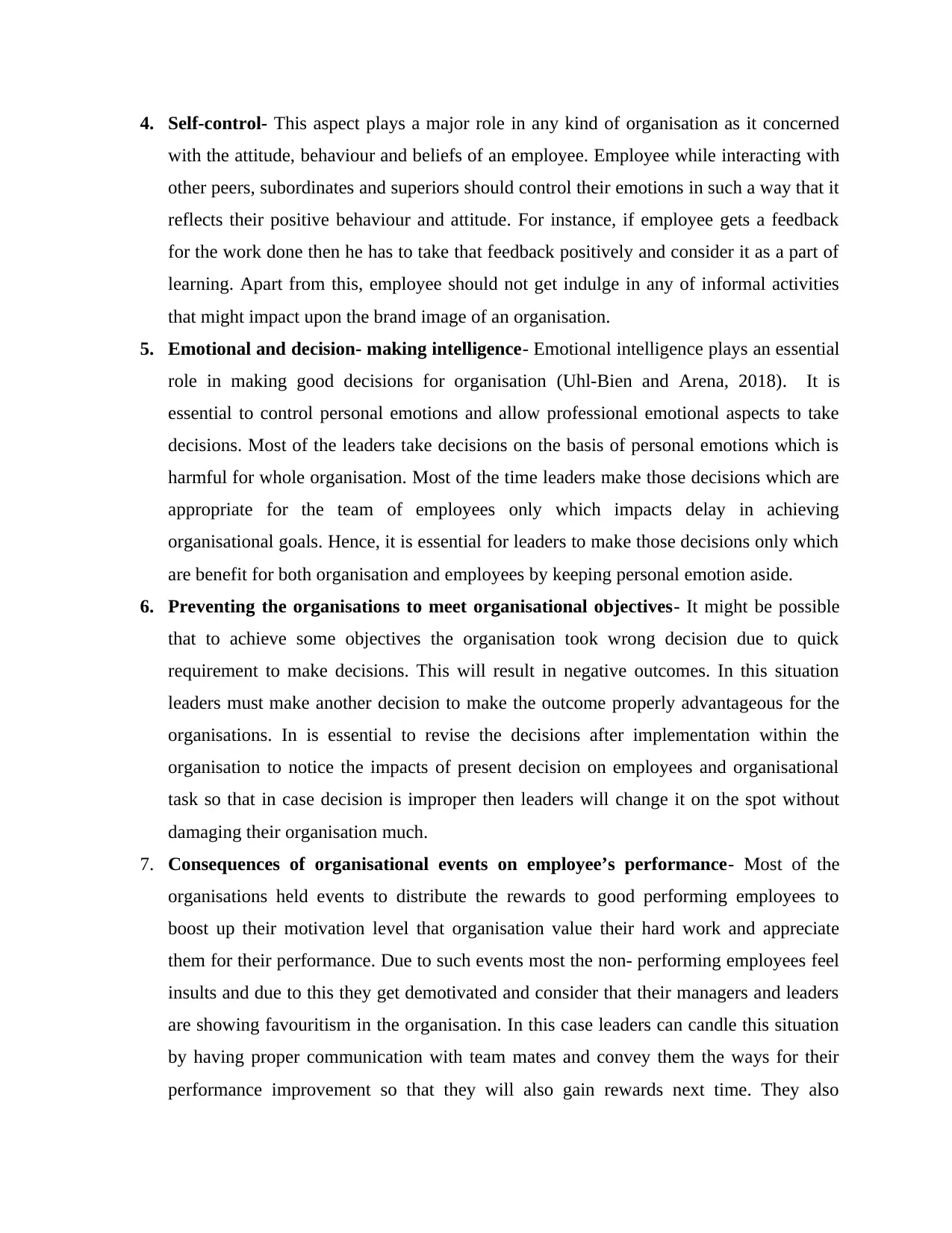
4. Self-control- This aspect plays a major role in any kind of organisation as it concerned
with the attitude, behaviour and beliefs of an employee. Employee while interacting with
other peers, subordinates and superiors should control their emotions in such a way that it
reflects their positive behaviour and attitude. For instance, if employee gets a feedback
for the work done then he has to take that feedback positively and consider it as a part of
learning. Apart from this, employee should not get indulge in any of informal activities
that might impact upon the brand image of an organisation.
5. Emotional and decision- making intelligence- Emotional intelligence plays an essential
role in making good decisions for organisation (Uhl-Bien and Arena, 2018). It is
essential to control personal emotions and allow professional emotional aspects to take
decisions. Most of the leaders take decisions on the basis of personal emotions which is
harmful for whole organisation. Most of the time leaders make those decisions which are
appropriate for the team of employees only which impacts delay in achieving
organisational goals. Hence, it is essential for leaders to make those decisions only which
are benefit for both organisation and employees by keeping personal emotion aside.
6. Preventing the organisations to meet organisational objectives- It might be possible
that to achieve some objectives the organisation took wrong decision due to quick
requirement to make decisions. This will result in negative outcomes. In this situation
leaders must make another decision to make the outcome properly advantageous for the
organisations. In is essential to revise the decisions after implementation within the
organisation to notice the impacts of present decision on employees and organisational
task so that in case decision is improper then leaders will change it on the spot without
damaging their organisation much.
7. Consequences of organisational events on employee’s performance- Most of the
organisations held events to distribute the rewards to good performing employees to
boost up their motivation level that organisation value their hard work and appreciate
them for their performance. Due to such events most the non- performing employees feel
insults and due to this they get demotivated and consider that their managers and leaders
are showing favouritism in the organisation. In this case leaders can candle this situation
by having proper communication with team mates and convey them the ways for their
performance improvement so that they will also gain rewards next time. They also
with the attitude, behaviour and beliefs of an employee. Employee while interacting with
other peers, subordinates and superiors should control their emotions in such a way that it
reflects their positive behaviour and attitude. For instance, if employee gets a feedback
for the work done then he has to take that feedback positively and consider it as a part of
learning. Apart from this, employee should not get indulge in any of informal activities
that might impact upon the brand image of an organisation.
5. Emotional and decision- making intelligence- Emotional intelligence plays an essential
role in making good decisions for organisation (Uhl-Bien and Arena, 2018). It is
essential to control personal emotions and allow professional emotional aspects to take
decisions. Most of the leaders take decisions on the basis of personal emotions which is
harmful for whole organisation. Most of the time leaders make those decisions which are
appropriate for the team of employees only which impacts delay in achieving
organisational goals. Hence, it is essential for leaders to make those decisions only which
are benefit for both organisation and employees by keeping personal emotion aside.
6. Preventing the organisations to meet organisational objectives- It might be possible
that to achieve some objectives the organisation took wrong decision due to quick
requirement to make decisions. This will result in negative outcomes. In this situation
leaders must make another decision to make the outcome properly advantageous for the
organisations. In is essential to revise the decisions after implementation within the
organisation to notice the impacts of present decision on employees and organisational
task so that in case decision is improper then leaders will change it on the spot without
damaging their organisation much.
7. Consequences of organisational events on employee’s performance- Most of the
organisations held events to distribute the rewards to good performing employees to
boost up their motivation level that organisation value their hard work and appreciate
them for their performance. Due to such events most the non- performing employees feel
insults and due to this they get demotivated and consider that their managers and leaders
are showing favouritism in the organisation. In this case leaders can candle this situation
by having proper communication with team mates and convey them the ways for their
performance improvement so that they will also gain rewards next time. They also
Paraphrase This Document
Need a fresh take? Get an instant paraphrase of this document with our AI Paraphraser
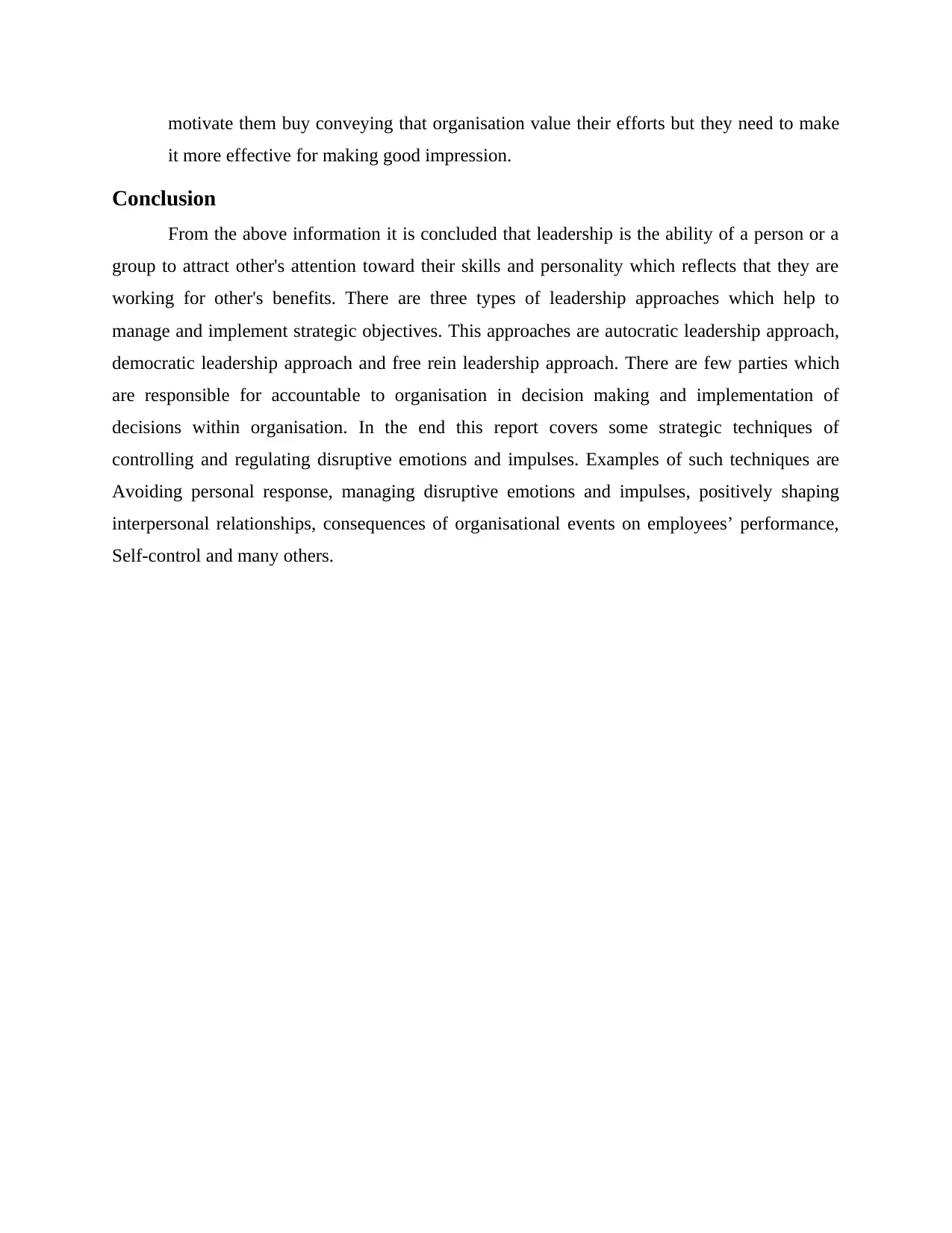
motivate them buy conveying that organisation value their efforts but they need to make
it more effective for making good impression.
Conclusion
From the above information it is concluded that leadership is the ability of a person or a
group to attract other's attention toward their skills and personality which reflects that they are
working for other's benefits. There are three types of leadership approaches which help to
manage and implement strategic objectives. This approaches are autocratic leadership approach,
democratic leadership approach and free rein leadership approach. There are few parties which
are responsible for accountable to organisation in decision making and implementation of
decisions within organisation. In the end this report covers some strategic techniques of
controlling and regulating disruptive emotions and impulses. Examples of such techniques are
Avoiding personal response, managing disruptive emotions and impulses, positively shaping
interpersonal relationships, consequences of organisational events on employees’ performance,
Self-control and many others.
it more effective for making good impression.
Conclusion
From the above information it is concluded that leadership is the ability of a person or a
group to attract other's attention toward their skills and personality which reflects that they are
working for other's benefits. There are three types of leadership approaches which help to
manage and implement strategic objectives. This approaches are autocratic leadership approach,
democratic leadership approach and free rein leadership approach. There are few parties which
are responsible for accountable to organisation in decision making and implementation of
decisions within organisation. In the end this report covers some strategic techniques of
controlling and regulating disruptive emotions and impulses. Examples of such techniques are
Avoiding personal response, managing disruptive emotions and impulses, positively shaping
interpersonal relationships, consequences of organisational events on employees’ performance,
Self-control and many others.
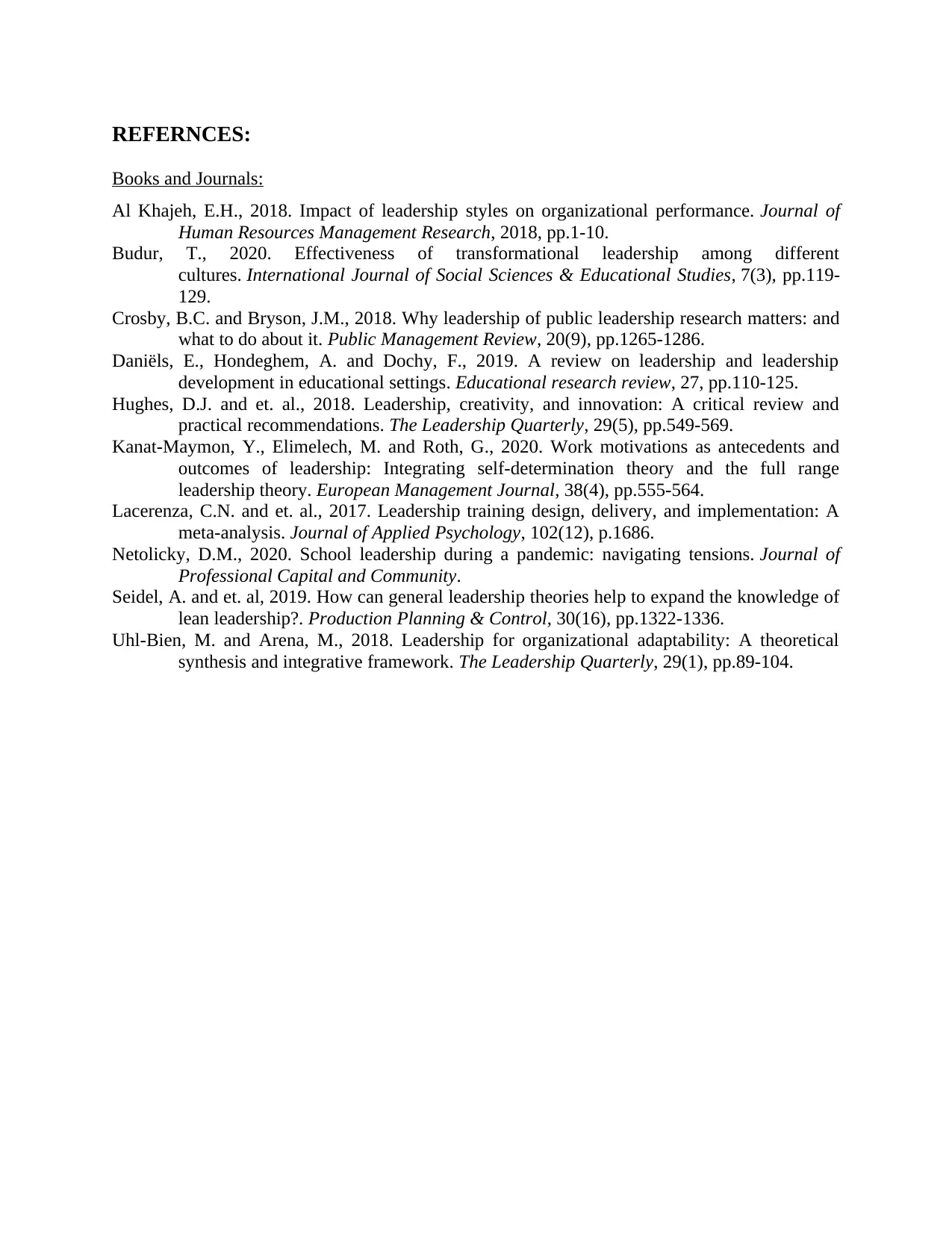
REFERNCES:
Books and Journals:
Al Khajeh, E.H., 2018. Impact of leadership styles on organizational performance. Journal of
Human Resources Management Research, 2018, pp.1-10.
Budur, T., 2020. Effectiveness of transformational leadership among different
cultures. International Journal of Social Sciences & Educational Studies, 7(3), pp.119-
129.
Crosby, B.C. and Bryson, J.M., 2018. Why leadership of public leadership research matters: and
what to do about it. Public Management Review, 20(9), pp.1265-1286.
Daniëls, E., Hondeghem, A. and Dochy, F., 2019. A review on leadership and leadership
development in educational settings. Educational research review, 27, pp.110-125.
Hughes, D.J. and et. al., 2018. Leadership, creativity, and innovation: A critical review and
practical recommendations. The Leadership Quarterly, 29(5), pp.549-569.
Kanat-Maymon, Y., Elimelech, M. and Roth, G., 2020. Work motivations as antecedents and
outcomes of leadership: Integrating self-determination theory and the full range
leadership theory. European Management Journal, 38(4), pp.555-564.
Lacerenza, C.N. and et. al., 2017. Leadership training design, delivery, and implementation: A
meta-analysis. Journal of Applied Psychology, 102(12), p.1686.
Netolicky, D.M., 2020. School leadership during a pandemic: navigating tensions. Journal of
Professional Capital and Community.
Seidel, A. and et. al, 2019. How can general leadership theories help to expand the knowledge of
lean leadership?. Production Planning & Control, 30(16), pp.1322-1336.
Uhl-Bien, M. and Arena, M., 2018. Leadership for organizational adaptability: A theoretical
synthesis and integrative framework. The Leadership Quarterly, 29(1), pp.89-104.
Books and Journals:
Al Khajeh, E.H., 2018. Impact of leadership styles on organizational performance. Journal of
Human Resources Management Research, 2018, pp.1-10.
Budur, T., 2020. Effectiveness of transformational leadership among different
cultures. International Journal of Social Sciences & Educational Studies, 7(3), pp.119-
129.
Crosby, B.C. and Bryson, J.M., 2018. Why leadership of public leadership research matters: and
what to do about it. Public Management Review, 20(9), pp.1265-1286.
Daniëls, E., Hondeghem, A. and Dochy, F., 2019. A review on leadership and leadership
development in educational settings. Educational research review, 27, pp.110-125.
Hughes, D.J. and et. al., 2018. Leadership, creativity, and innovation: A critical review and
practical recommendations. The Leadership Quarterly, 29(5), pp.549-569.
Kanat-Maymon, Y., Elimelech, M. and Roth, G., 2020. Work motivations as antecedents and
outcomes of leadership: Integrating self-determination theory and the full range
leadership theory. European Management Journal, 38(4), pp.555-564.
Lacerenza, C.N. and et. al., 2017. Leadership training design, delivery, and implementation: A
meta-analysis. Journal of Applied Psychology, 102(12), p.1686.
Netolicky, D.M., 2020. School leadership during a pandemic: navigating tensions. Journal of
Professional Capital and Community.
Seidel, A. and et. al, 2019. How can general leadership theories help to expand the knowledge of
lean leadership?. Production Planning & Control, 30(16), pp.1322-1336.
Uhl-Bien, M. and Arena, M., 2018. Leadership for organizational adaptability: A theoretical
synthesis and integrative framework. The Leadership Quarterly, 29(1), pp.89-104.
⊘ This is a preview!⊘
Do you want full access?
Subscribe today to unlock all pages.

Trusted by 1+ million students worldwide
1 out of 9
Related Documents
Your All-in-One AI-Powered Toolkit for Academic Success.
+13062052269
info@desklib.com
Available 24*7 on WhatsApp / Email
![[object Object]](/_next/static/media/star-bottom.7253800d.svg)
Unlock your academic potential
Copyright © 2020–2025 A2Z Services. All Rights Reserved. Developed and managed by ZUCOL.





